 Art in the Blood: A Sherlock Holmes Adventure takes place in 1888, in London, Paris, and Lancashire. Below are annotations, arranged by chapter, which give interesting facts on many historical and Sherlockian people, places and things that appear in the book.
Art in the Blood: A Sherlock Holmes Adventure takes place in 1888, in London, Paris, and Lancashire. Below are annotations, arranged by chapter, which give interesting facts on many historical and Sherlockian people, places and things that appear in the book.
For more information on the book, please see here.
NOTE: Spoilers follow.
It is suggested you read these along with the book, rather than in advance.
- CHAPTER ONE – IGNITION
- CHAPTER TWO – ENROUTE
- CHAPTER THREE – WE MEET OUR CLIENT
- CHAPTER FOUR – LE LOUVRE
- CHAPTER FIVE – LES OEUFS
- CHAPTER SIX- LE CHAT NOIR
- CHAPTER SEVEN – ATTACK!
- CHAPTER EIGHT- A SLIPPERY SLOPE
- CHAPTER NINE – L’ARTISTE EN DANGER
- CHAPTER TEN – MADEMOISELLE LA VICTOIRE’S STORY
- CHAPTER THIRTEEN – MYCROFT
- CHAPTER FOURTEEN- ARMED WITH LIES
- CHAPTER SEVENTEEN- IN THE BOSOM OF THE FAMILY
- CHAPTER EIGHTEEN – FIRST LOOK
- CHAPTER NINETEEN – MURDER!
- CHAPTER TWENTY-THREE – TERROR LOOMS
- CHAPTER TWENTY-FOUR
- CHAPTER TWENTY-FIVE
- CHAPTER TWENTY-SIX
- CHAPTER TWENTY-SEVEN
- CHAPTER THIRTY
CHAPTER ONE – IGNITION
Jack the Ripper
While theories abound as to the identity of the Ripper, no public solution to the Ripper case was ever officially announced. The last murder, which is popularly agreed on as the work of this serial killer, took place in November of 1888, during the month preceding this tale. It is probable that Sherlock Holmes was involved in some way in the investigation and if so, may very well have discovered the identity of the murderer. This recently discovered Watson manuscript implies that he did, and that there was some negative political fallout for the great detective. One theory is that a member of the royal family, or some other titled personage was implicated and perhaps this explains Holmes’ incarceration. Another is that the bungled investigation revealed gross inadequacies in the relatively new police system of the time. As someone who would never put political niceties before his pursuit of the truth, Holmes can be presumed to have run foul of someone during this investigation. Perhaps that is why no official account of his involvement exists, though scholars debate this last conjecture as well and a number of Holmes/Ripper accounts have been put forth.
Mrs. Hudson’s Accent
In this manuscript Mrs. Hudson, under extreme duress, appears to lapse into a Scottish dialect, which is not heard elsewhere in Watson’s accounts. It seems to confirm the theory based on her ideas of breakfast, that indicate a Scots background, and perhaps is heard only here because of her reaction to the fire and her worry over Holmes. Or it may well be an error in transcription as indeed it is in one of the blurred areas.
Jicky Perfume/Cologne
“Jicky” by Guerlain is arguably the oldest perfume still in production and is still worn. It was first released publicly in 1889, one year after this story. As a celebrity, Mademoiselle La Victoire of our tale probably obtained a bottle in its testing phase.

Holmes made it a point to have an encyclopaedic knowledge of perfumes as he did of inks, pens, cigar ash, and many other things, and accordingly must have stayed abreast of new developments in the field. At about this time, this task became instantly more complex. Jicky is considered the first “modern” perfume because it is a mixture of several scents. Prior to that, single notes, such as lavender or rose, were de rigeur. Jicky has a distinctive spicy, fresh quality with a vanilla note (one is reminded of gingerbread) although it is officially described as having top notes of citrus and lavender, middle of rose and orris, and bottom of vanilla and amber, among more.
The original bottle design celebrates the times – the bottom half resembled a chemist’s bottle as a nod to technology and science; the top was designed to resemble a champagne cork!
Jicky was released as what would now be called a “unisex” scent and, at the time would have been a highly daring choice for a woman. It has, in the intervening years, been the signature scent of a number of famously alluring individuals including Sarah Bernhardt, Brigitte Bardot, Cary Grant, and Sean Connery.
Disappearing/Invisible Ink
The letter from Mademoiselle La Victoire employs two techniques of steganography, or hidden messaging: “disappearing ink,” which fades under light or air, and “invisible ink,” which can be made to appear with the application of heat or a chemical, both written with a typical dip pen of the time.

Both have been a favourite of spies, the military and plotting royals for centuries. Their double use here intrigues Holmes to a great degree as this implies considerable skill and intelligence on the part of the writer.
The initial disappearing ink, which appears to be pink is phenolphthalein dissolved in a basic solution, such as lye. Both chemicals were readily available at the time: phenolphthalein was commonly used as a laxative, and lye was used as a cleaner and in the making of soap.
Holmes would have been quite familiar with phenolphthalein as it is used to test materials for the presence of blood. (In reality this test, the “Kastle Meyer” was first described in 1903 – but one can presume Holmes, as an amateur but accomplished chemist, to be a bit ahead of published science in this area.) In “A Study in Scarlet” he is thrilled to discover a reagent that reacts in the presence of blood but nothing else.
It is likely that Holmes suspected the second message, in “invisible” ink, for three reasons; the first would be his intuitive sense that the writer had more to say, the second is that his extraordinarily sensitive sense of smell detected a secondary odour underneath the perfume (potato?) and third, he saw, upon examination with a magnifying glass, some small scratches in the paper, which did not correspond to the writing of the first message.
Most invisible ink is designed to be revealed by heat, but the trickier ones are revealed by a second chemical. Examples include starch (including a slurry of potato and water, probably used here), which is revealed by iodine. Another could have been salt developed by silver nitrate. Holmes’ application of the correct chemical (from his abundant supply) would have revealed the second message.
CHAPTER TWO – ENROUTE
Elgin Marbles
This British acquisition of a big chunk of the Parthenon in 1816 is a controversial issue to this day. Thomas Bruce, the 7th Earl of Elgin, is famous for carving up the works while serving as the British ambassador to the Ottoman Empire from 1799 to 1803. After much debate, the marbles were purchased by the British government in 1816 and placed on display in the British Museum where they reside today.

Elgin is both lauded for saving these from certain destruction but also reviled as a vandal, the latter quite eloquently by Lord Byron in this furious poem:
Dull is the eye that will not weep to see
Thy walls defaced, thy mouldering shrines removed
By British hands, which it had best behoved
To guard those relics ne’er to be restored.
Curst be the hour when from their isle they roved,
And once again thy hapless bosom gored,
And snatch’d thy shrinking gods to northern climes abhorred!
However, many argue that the sculptures, later cleaned by a method devised by famous scientist Michael Faraday, were best restored, protected and made available for public view in Britain, and to this day the subject is vehemently argued. Holmes refers to this controversy and the general tendency of the time for many great art pieces to make their way to Britain during the height of the Empire’s power.

Mackintosh
A “mackintosh” was a raincoat made with fabric that had been vulcanised or rubberised. When it was struck by rain, the water rolled right off; hence the analogy to the untouchable Earl. This fabric, patented in the 1820s, was originally a layer of rubber between two fabric sheets – but the smell was offensive, and the material could turn stiff or even melt in hot weather.
After the temperature-resistant “vulcanized ” rubber was developed in 1839, “macs” became very popular. In Watson’s account of “The Silver Blaze,” the murdered John Straker pulls on a mackintosh, which is later found “flapping from a furze bush” near his body.
In America, the Goodyear Rubber Company, among others, experimented with many rubber coated fabrics.
The Mackintosh Company survives today, and was repositioned as a luxury brand in 2011. The famous coat by Belstaff worn by Benedict Cumberbatch in BBC Sherlock is not technically a “mac” but is so in spirit – it is crafted from an Irish tweed with a modern coating that sheds rain, yet remains breathable and soft.

This is fortunate as BBC Sherlock’s first two seasons were filmed in mid-winter. This photo by the curator shows the Sherlock star in pouring rain in his impermeable coat during Season Three shooting in April of 2013.
Nike
The Goddess of Victory (Victoria to the Romans) is the subject of one of the world’s most famous and beautiful sculptures, The Winged Victory. More on her later. In Greek mythology, Nike was the “divine charioteer” who was summoned by Zeus to help him in the Titan wars against older deities. While her presence was said to confer victory, she was not just about winning – the Nike was also said to respect “the balance of power.” Other famous sculptural depictions of Nike are on the Arc de Triomphe in Paris (standing 52 years at the time of this story) and on the Victoria Memorial, which did not yet exist at the time of this adventure.
CHAPTER THREE –WE MEET OUR CLIENT

Montmartre in 1888
Perched on a steep hill in the northern part of Paris, Montmartre in 1888 was the “happening” place. Renowned for its cabarets and café-concerts, the area boasted a wild nightlife, which attracted visitors of all classes. This illustration by Vidal portrays the commercialized view of this time and place…

…while this painting by Adolphe Willette, which hung on the wall of Le Chat Noir conveyed a sharper look at the dark, sophisticated humor and risqué energy of the place – fueled by alcohol, music and the spirit of rebellion..
Once a rural area filled with vineyards and windmills, only seventeen years earlier in 1871, Montmartre had been the epicenter of the bloody revolution in Paris. But by 1888, Montmartre had morphed into a Bohemian haven. Students, artists, writers, and musicians had recently abandoned the 5th arrondissement and flocked there for the shows, the coffeehouses, the intellectual, artistic camaraderie – and the absinthe. Everyone else, from the wealthy to the workers, followed in droves.

At the base of Montmartre’s steep hill were what Van Gogh called “les grands boulevards” an elegant area which attracted established artists such as Degas, Renoir, and Moreau. Here is a glimpse in winter at the time of this tale.
As one ascended the steep hills, strong traces of agricultural beginnings were still visible with windmills and vineyards tucked between houses.

The cheaper rents near the summit housed younger up-and-comers like Lautrec and Van Gogh. And perhaps Mademoiselle La Victoire, who, while successful was still quite young.
By 1888 Montmartre was the centre of impressionist and post impressionist art. Lautrec, Van Gogh, Degas, Renoir, their model Suzanne Valadon and her son, Utrillo, among many more lived, worked, and partied there. The place and time were memorialized by many artists, most notably Lautrec.

Le Franc Buveur
Holmes’ favourite café has existed on this site in Montmartre for nearly four centuries, according to the website of “Auberge de La Bonne Franquette”, its current occupant. This photo picture was taken in 1910 and may be similar to what Holmes and Watson experienced.

This 1888 sketch of the patio area by Van Gogh painted the same year as our story, is rumoured to be Le Franc Buveur, If so, it could be exactly what Holmes and Watson saw.
And finally, here is the restaurant today, now called the Auberge de la Bonne Franquette. The billiard tables are long gone.


Cherie Cerise/ Mademoiselle La Victoire
While no references to Holmes’ client emerge from the period we can only conjecture her actual appearance. As she was a close friend of Toulouse Lautrec, he must have painted her. Could his famous “Woman with Gloves,” reputed to be of an unknown named “Honorine Platzer” actually be Cherie Cerise/ aka Mademoiselle La Victoire? And might that have been her real name?

Brown’s Hotel, London
Brown’s Hotel on Abermarle Street in London, where Mademoiselle La Victoire dined with her son each December, opened in 1837 and remains to this day one of London’s premiere hotels. Arthur Conan Doyle himself stayed there, as did Oscar Wilde, Theodore Roosevelt (two years before this tale), Bram Stoker, Rudyard Kipling, and many more. The tearoom has been famous for decades and remains (see contemporary photo below) very like it was during the time of this story, with original panelling and traditional decor.

Tanner’s Scraper Knife
The curious “knife,” which resembles a ladle, described by Mademoiselle La Victoire is recognized by Holmes as a “dry scraper” – a specialty tool in the tanning trade. The blade has a rounded edge (which is nevertheless quite sharp) and is designed to scrape hides without puncturing them. This inefficient weapon confirmed Holmes’ suspicions that the man “threatening” Cherie was probably not a criminal, and also that he had access to tanning tools.
CHAPTER FOUR – LE LOUVRE

La Tour Eiffel
In 1888, construction began on the “monstrosity” soon to be known as the Eiffel Tower in preparation for the 1889 Paris Exposition. Many Parisians were horrified, and felt it would last no more than a year – if that. In December of 1888 at the time of Holmes’ and Watson’s visit, it was in exactly this state.

Le Louvre
By the time of this tale, the Louvre was a centre of culture and art, but it was not always so. Constructed and reconstructed over and over for centuries, it began as a fortress and armoury in the Middle Ages. Later it was a grand royal residence, then lay dormant for a century. Once again resurrected for other purposes including government proceedings and sumptuous royal apartments,

In 1871, the nearby Tuilleries Palace was gutted by fire, and finally demolished in 1883. This marked a change for the Louvre into a true cultural centre for the people. At first the museum was only open for artists and the nobility, but later for the public, who were allowed in only on Saturdays. Here’s how it no doubt looked to Holmes and Watson.

The north wing along the Rue de Rivoli, where Holmes was to meet Watson after his appointment, expanded greatly during the 1870s, as evidenced by this picture.
In 1888, the year of this story, major additions to the newly created Department of Near Eastern Antiquities caused a whole new set of rooms to be added including the Susa Gallerie.
The Louvre would have been a very exciting place for someone with artistic interests. Holmes, as it turns out, had a great many family ties there.

The Vernet Family
It is well known that Holmes’ grandmother was a sister of the artist, Vernet, (making him Holmes’ great-uncle) and that this famously endowed him with “art in the blood.” But there was more than one artist in this family, so perhaps Holmes was multiply blessed. (Or cursed).
Which Vernet, then, was Holmes’ great uncle? Most probably it was Horace Vernet (1789-1863) who was the youngest of three generations of Vernet artists. Horace, as Watson recalls, specialized in portraits, military, and “Orientalist” (Arab) subjects. Here is Horace Vernet’s “Self Portrait With Pipe” which resides at the Louvre. A “three pipe problem” of this size would be formidable.

Below is another of Horace’s portraits, his daughter, Louise Vernet, aged sixteen, in Rome where Horace was director of the Villa Medici from 1828 to 1833.
This stunning heartbreaker, who would be Holmes’ first cousin once removed, was wooed by Hector Berlioz, married another artist, and died tragically of brain fever at age 31.
The rest of the Vernet family had a colourful history as well. Horace was born into chaos inside the Louvre itself where his artist family had taken refuge during the violence of the French Revolution. As painters of the aristocracy, they would have been seen as enemies of the populist cause, and Horace’s aunt Marguerite was arrested on the trumped up charge of owning too many candles (and being friends with many aristocrats). She was guillotined along with her friend, Marie Antoinette.

This devastated her brother, Carle, who was Horace’s father and a famous artist in his own right. Carle Vernet (1758-1836), previously known for military subjects and particularly horses, was said to have never painted seriously again. The very emotional Carle (who as a young man tried to join a monastery in a reaction to a broken romance) was Holmes’ great grandfather.
Incidentally, Carle married the daughter of the minor artist Jean-Michel Moreau, who was famous for having illustrated a book at the tender age of 12. And so Holmes great-grandmother contributed even more “art in the blood.”

But the Holmes’ art connection does not end there. Carle Vernet’s father was also an artist, Joseph Vernet. Highly successful, Holmes’ handsome great great grandfather Joseph was reputed to be kind, heroic and generous. His resemblance to Holmes is noticable in this portrait by Élisabeth Vigée-Le Brun.

Joseph was commissioned by Louis XV to paint a series of the “ports” of France. During this period in art, portrayals of the highly dramatic and “terrible” were in great demand. Here’s a rather emotional example painted by Holmes’ great great grandfather:
Joseph married an Englishwoman of Irish descent, Cecilia Virginia Parker, daughter of the commander of the Pope’s navy, whom he met in Rome while she was taking the Grand Tour, so she was presumably an aristocrat. She, in turn, was said to have descended from an Archbishop and later went mad. Thus we have more clues to Holmes’ ancestry and “artistic nature.”
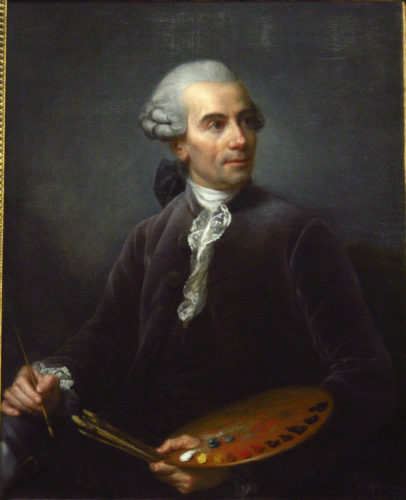
Joseph was by all accounts a happy man. This sketch by Quentin de la Tour reveals a possibly impish side which surfaces, though rarely, in his great great grandson Sherlock Holmes.


Portrait Of Isabey
Holmes and Watson discuss this portrait painted by Horace Vernet. Isabey himself was a famous and colourful painter, favoured at Versailles. A line of artists’ brushes named for him was created in 1894 and is still sold today.
Note: This portrait still resides in the Louvre; however, it was acquired in 1891, three years after this story. Could Watson be mistaken in his dates, here? It would not be the first time. The date of the case is unlikely to be mistaken as it follows hard upon the Ripper incidents. Perhaps he is confusing this particular Vernet sighting with a later visit to the Louvre with Holmes, or perhaps with his wife, Mary, née Morstan, before her untimely death. We do know that much time elapsed between some of the cases and Watson’s recounting of them.

The Winged Victory
The Winged Victory of Samothrace is one of the crowning glories of the Louvre collection and has resided in a dramatic setting on the Daru staircase since her installation in 1886. At the time of this writing, she can still be seen where Holmes and Watson stood.
Similar to the missing statue of this tale, The Winged Victory depicts the goddess Nike. A statue even close to this in size and quality would have been priceless.
The Winged Victory herself is reputedly the most beautiful statue in the world. She is, as Watson points out“missing her head” and various other parts as well. The hand has since been found and is displayed in a glass case nearby. In fact, the right wing and the left breast are not original but added on shortly before this tale, the restorers operating under the assumption that the wings were symmetrical. More recent finds in Samothrace indicate they were not. Such restoration would not likely be performed today. At the time of this annotation writing, the Winged Victory was currently off display and being cleaned.
CHAPTER FIVE – LES OEUFS

The Madeleine
This popular area near the center of Paris is where Holmes and Watson found their hotel. Here’s what it looked like in the winter at that time.
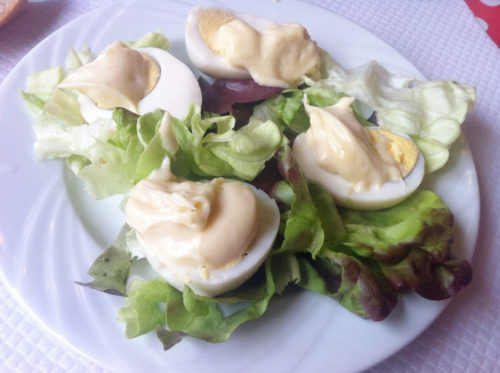
Oeufs Mayonnaise
We travel now from the glorious to what seems the mundane. Hard-boiled eggs with mayonnaise sound like nothing special. But when you have it Parisian style, with hand-made fresh mayonnaise, and perched on some delicate salad, you have touched a bit of culinary heaven. For someone apparently uninterested in food, Holmes nevertheless displays some of his French propensities here.
CHAPTER SIX- LE CHAT NOIR

Le Chat Noir
At the time of this story, this famous cabaret had been open for seven years and had already expanded from its first and second locations to its third location, 68 Boulvard de Clichy.
It was the epicentre of artistic Bohemian Paris, and a popular destination for visitors from all walks of life.

In the depiction below, the translucent screen of the Théâtre d’Ombres (more on this later) is seen to the right, the hanging stuffed creature, the artwork, and the crowds at long tables are clearly visible.
Impresario Rodolphe Salis came up with the name “Le Chat Noir,” which means “The Black Cat” from a Gothic short story by Edgar Allan Poe. To liven up his new cabaret, he invited a raucous group of writers and artists, the self-styled Hydropathes (those “afraid of water” preferring instead copious amounts of wine and beer) to hang out at his place in Montmartre. This signalled a transfer of Bohemian nightlife from the Latin Quarter to Montmartre.
A later host was singer Aristide Bruant, famously featured with his trademark scarf in poster by frequent guest Toulouse Lautrec.
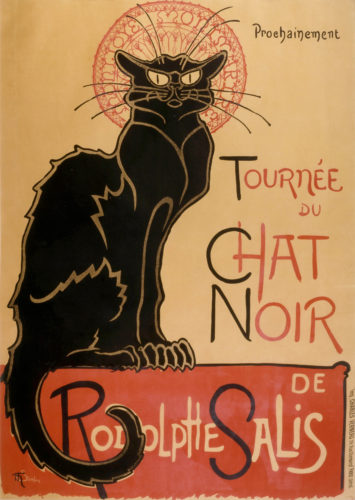
At Le Chat Noir, Salis started the trend of combining a bar with entertainment. Guests sat at tables while enjoying a variety show, a kind of chaotic scene we might call “open mic” as host Salis regaled and teased the audience in between the acts. Salis once famously addressed the future King Edward of England, by “Well, look here: it looks like the Prince of Wales all pissed.” (drunk).

In addition to the musical and poetic presentations, the ribald and wildly original Théâtre d’Ombres (see below) drew fascinated crowds. Sadly nothing remains of the original establishment except a seedy modern bar of the same name on the completely rebuilt final location of the cabaret, 68 Boulevard de Clichy.
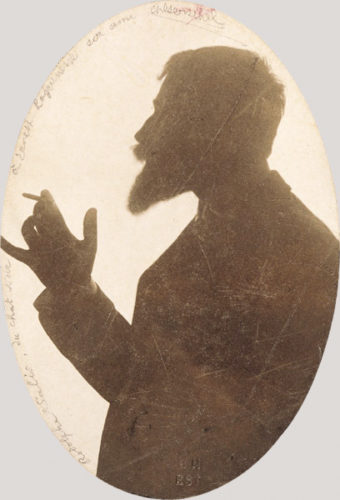
Absinthe
One wonders why Holmes brings Watson absinthe, given the dangerous nature of their mission, but it is perhaps an example of his detached scientific curiosity, or more likely, his sense of humour. He does advise a taste only, and wisely so.
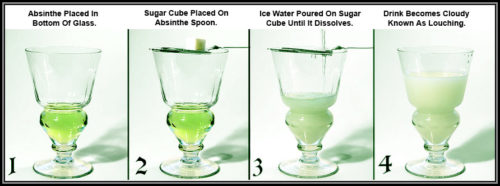

Absinthe, or “the green fairy” was reputed to be hallucinogenic, and this notion was popularized by Lautrec and Van Gogh, and below, by Polish expat Viktor Oliva:
Even Oscar Wilde “described a phantom sensation of tulips brushing against his legs.” Chemical analyses of samples from the period show no hallucinogenic components, however, and it is now thought that possibly there were adulterants added which may have caused these effects.

In any case, the torpor and the peculiar “lucid intoxication” it caused (and the predilection for addiction) made absinthe an extremely dangerous drink.
It was banned in France in 1915 as it was thought to drive people insane. Even now, absinthe containing more than 10% thujone, is banned for sale in the United States, though available elsewhere. Thujone affects the nervous system and can cause convulsions.
CHAPTER SEVEN – ATTACK!

The Théâtre D’Ombres
The “Theatre of Shadows” as seen at Le Chat Noir was a newly popular art form, based on Balinese shadow puppets, and developed in the nineteenth century by artist/photographer Henri Rivière (whose Eiffel Tower photo you have seen earlier). However they had also been popular at Versailles a century before.
Cutouts, in zinc, were manipulated behind a translucent screen by a number of stagehands. What audiences saw was a series of figures (and scenery) moving across the screen, in a number of sharply satiric, occasionally scatological, and generally scandalous presentations, written by local writers and narrated by Salis. A popular one in 1888 was L’Épopée, the story of Napoleon. Cutouts for this one were designed by Caran D’Ache. Here’s an example.

And here is the room in the Chat Noir with the Théâtre d’Ombres in an 1889 drawing by Caran D’Ache. Presumably the torn screen of Holmes and Watson’s adventure had been repaired by then.

Backstage at the Théâtre d’Ombres was a hive of activity. Behind the screen the zinc cutout figures were mounted in racks, the varying sizes and distance from the screen creating perspective. They were manipulated by up to twenty stagehands in order to bring the unique shows to life. The illustration and photograph below give an idea of the crowded intensity backstage.

At that time, the light source was the dangerously explosive “limelight,” a strong oxy-hydrogen lamp which blasted light at the back of the screen. It was later replaced in all theatres by the much safer electrical light.


The Stiletto
Originating in the middle ages, the long, thin knife known as a stiletto has long been the preferred weapon of assassins, as it is small, silent, easily concealed and capable of inflicting great bodily harm. Additionally it had the advantage of being able to pierce armour, by slipping into tiny spaces. It leaves only a small wound but causes deep internal injury, and often the recipient of a stiletto stab wound dies of internal bleeding. The one in this story might well have looked like one of these. The blade shape is traditionally triangular.
Immensely popular in Sicily, and the signature weapon of early Mafia, the scherma di stiletto siciliano or Sicilian “swordsmanship (method) of stiletto fighting” taught the fighter to plunge in the narrow knife, then twist the blade around for maximum damage. The use of the stiletto by the attackers in this story was key for Holmes to connect the Marseilles Nike murders and the attack at Le Chat Noir.
The Mafia
In “The Six Napoleons,” Watson refers to the Mafia, who featured in that tale. In Sicily around 1861, a political upheaval created a large number of vulnerable new small landowners who found themselves under siege from marauding politicos, thieves and each other. A group offering “protection” for a fee, arose as a benign entity to defend these peasants but grew in power, altered its nature, and gradually turned into what we know of as the Mafia. While direct references to “The Family” or “Cosa Nostra” (literally “Our Thing”) are not easily found at the time of this story, the Mafia did exist. Prominent in New Orleans at precisely this time, the Mafia remained in power there through Prohibition. The Italian immigrants in that city used stilettos in so many stabbings and murders that an ordinance was passed in 1879 outlawing their sale within the city limits. In Victorian London, in the largely Italian neighbourhood of Saffron Hill, the organization was known and feared.
CHAPTER EIGHT- A SLIPPERY SLOPE

The Real Vidocq
The Vidocq of this story claims to be a direct descendant of the famous real-life criminal-turned-lawman Eugène Vidocq, but as Holmes points out, the claim is most probably spurious, as no proven family lines exist. The name Vidocq (1775-1857) is famous in France, and indeed the world over, as the originator of modern police force, and creator of the first private detective agency. A friend of Victor Hugo, Eugène Vidocq was a reformed thief and forger who later became a hero, and served as the model for the character Jean Valjean of Les Misérables.
A colourful and erratic character, the real Vidocq lived a complex life. As a youth, he was a petty thief, apprenticed with a theatre troupe (a Holmesian connection), became a master fencer (another parallel), but unlike Sherlock Holmes, he killed two men in duels, was a soldier, deserter, serial womanizer, and ultimately a forger. While jailed, Vidocq learned a French martial art called savate, derived from stickfighting and kickboxing. He also turned police informer, was released and continued his work with the police, eventually founding and heading the Sûreté Nationale, as well as what may have been the first private detective agency, making him at least a spiritual cousin to Holmes.
Eugène Vidocq instituted what is considered one of the first scientific methods of cataloguing the physical characteristics of criminals so that positive identification could take place, a method later surpassed by his compatriot Berthillon. Possessed of a near photographic memory for people and criminal methods (not unlike Holmes’ mind palace) Vidocq apparently famously deduced the perpetrators of several crimes by a detailed anaylsis of the clues found at the site. Unlike Holmes, however, Eugène Vidocq retained his own violent and criminal tendencies and found himself on both sides of the law throughout his long life.
CHAPTER NINE – L’ARTISTE EN DANGER

Toulouse-Lautrec
Artist Henri de Toulouse-Lautrec, twenty-four at the time of this story, was already a fixture in the nightlife of Montmartre. Famous for his depictions of café, bordello and circus life, he was a friend to many entertainers and ladies of the night whom he immortalized in his paintings. From posters to paintings, pastels to sketches, Lautrec captured the time and place.
Aristocratic by birth, but dwarfed by childhood injuries coupled with a congenital condition, Lautrec felt socially marginalized in spite of his popularity and success. He was a heavy drinker who loved to party in costume, and he entertained frequently.
What is little known about the famous artist was that he was an enthusiastic Anglophile and spoke English, although apparently not as well as he thought.
Lautrec frequented Le Chat Noir. He had a sense of humour about himself and is quoted as follows, “I had placed my stick on the table, as I do every evening. It had been specially made to suit my height, to enable me to walk without too much difficulty. As I was standing up, a customer called to me: ‘Monsieur, don’t forget your pencil.’ It was very unkind, but most funny.”



Lautrec’s vibrant social life stands in stark contrast to Holmes’ preferred isolation. But the artist’s intense focus on work, disregard for his health, his emotional nature, and tendency toward addictive substances rendered him similarly vulnerable. It is no wonder that he required a supportive and more grounded companion, who happened to be a member of the medical profession… not unlike Holmes’ Dr. Watson. (See Dr. Henri Bourges). In spite of this, Lautrec’s addiction to alcohol and probably other substances is considered to have hastened his early demise at only 36.
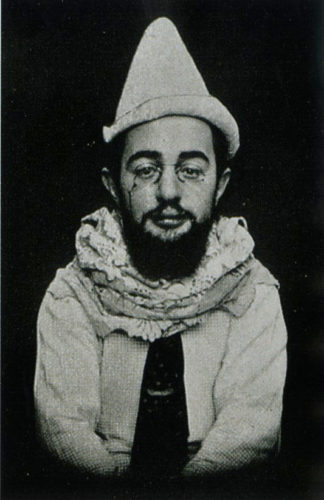



In December of 1888 Lautrec’s studio and arguably his home was at 27 (now 21) Rue Caulaincourt in Montmartre. Above is a photo of the inside, and here, what the exterior of the building looks like recently. Note the light source in the expanded window.

The “Earthquake”
“Cocktails”, an American invention, were taking Europe by storm at around this time. The Earthquake is a very real killer cocktail that will “rock your world” and was indeed invented by Toulouse Lautrec, who called it a “Tremblement de Terre” or “The Earthquake.” It is equal parts absinthe and cognac, and is best served in an absinthe glass.
The website “Absinthe Online” suggests you “swirl well to avoid eye tearing.” Try this concoction at your own risk.
Here is Lautrec, drinking absinthe with a friend.

Dr. Henri Bourges
Dr. Bourges, a physician, was a childhood friend of Lautrec’s and lived with him, as the first of several companions who tried to keep the emotional and depressive artist from drinking himself to death. The full-length portrait of the very real Dr. Henri Bourges was painted by Lautrec in 1891 three years after this tale.
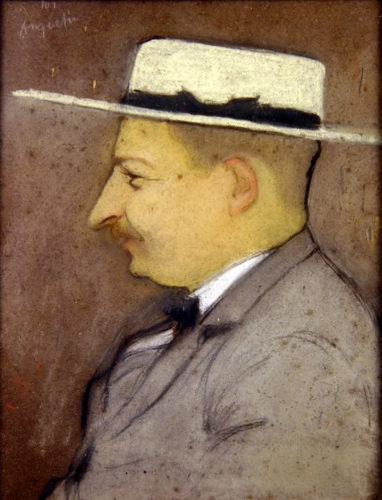
In contrast to his theatrical friend, Dr. Bourges was a conservative, dignified and pleasant young man, who later made a name for himself with a well-regarded publication on diphtheria.
As did Watson with Holmes, Bourges lived with Lautrec until he married in 1893. At the time of this story, they were living together. Watson’s and Bourges’ parallel roles with their brilliant companions can only be inferred. This humorous photo appears to mock this very real relationship.

CHAPTER TEN – MADEMOISELLE LA VICTOIRE’S STORY

The Grand Hotel Du Louvre
The hotel where the Earl entertained Mademoiselle La Victoire during their fateful liaison opened in 1855 as Paris’ first “Grand” Hotel. At that time it was located in what is now the Louvre d’Antiquaires. In the 1887, shortly before this story, it was moved to its present location in the Place Andre Malraux. The hotel included under its roof 700 guest rooms, steam-driven elevators, a post office, telegraph room, and exchange bureau. Sir Arthur Conan Doyle stayed there, and it is mentioned as well in Watson’s account of The Bruce Partington Plans.
CHAPTER THIRTEEN – MYCROFT

Hard Labour During Imprisonment
When Mycroft Holmes rather obliquely threatens his brother with a possible prison term at hard labour this could have meant a variety of things. Prior to the Gladstone Report of 1895, and therefore at the time of this story, prison in Britain was viewed as both punishment and deterrent, rather than anything akin to rehabilitation, and hard labour sentences were common, and quite harsh. This might mean grueling but productive labour such as quarry work, or dredging the Thames. But more often it meant pointless, punitive tasks such as walking a treadmill or remaining alone in one’s cell turning “The Crank,” a useless device which was capable of being tightened to the point that it required immense brute force to move it.

In spite of Holmes’ renowned physical strength and stamina while on a case, one can well imagine that the monotony, isolation, and repeated physical strain of a prison sentence at hard labour would lead to a breakdown – an idea not lost on Watson. The brilliant, artistic, and emotional Oscar Wilde, after being imprisoned in Pentonville and subjected to the treadmill as pictured below, emerged a broken man, never to recover fully.
CHAPTER FOURTEEN- ARMED WITH LIES

Wheelchair
Wheelchairs of the era were generally awkward contraptions of wicker, metal and wood, rarely with padding and not generally collapsible. The most common type was the “Bath” chair, invented by John Dowson in Bath, England with one wheel in front and two larger behind and a kind of hooded top to protect the invalid from the weather. Comfort became a concern and a reclining back was added to the more austere designs. Bicycle technology added rubber wheels and steel spokes. Henry Jennings takes credit for the first foldable wheelchair in 1932 and while there is no direct evidence for a custom, decorative, foldable one such as described in this story, the technology could have existed in 1888. The photo is an artistically designed (though not foldable) one of the era.
CHAPTER SEVENTEEN- IN THE BOSOM OF THE FAMILY

Géricault’s “Portrait Of A Kleptomaniac”
There is indeed a “Portrait of a Kleptomaniac” painted by Theodore Géricault in 1822—one of ten portraits of insane inmates of a Paris asylum the artist made at the behest of a psychiatrist.
Géricault’s paintings in this series “are noteworthy for their bravura style, expressive realism, and for their documenting of the psychological discomfort of individuals, made all the more poignant by the history of insanity in Géricault’s family, as well as the artist’s own fragile mental health,” said Patrick Noon in Crossing the Channel, 2003.

Battle Of Abu Klea
A celebrated battle of January 17, 1885 in which outnumbered British forces successfully overcame a formidable and dangerous battalion of Sudanese Mahdist warriors in the hopes of arriving in time to support General Gordon in Khartoum (ultimately a doomed endeavour). In this battle, the highly effective British army manoeuvre of “the square” was famously breached and yet the well-trained soldiers ultimately triumphed over the energetic, fit, and also experienced Sudanese enemy.
The battle lasted only fifteen minutes but saw seventy-four British and over one thousand Sudanese soldiers killed. It would have been quite an honour to have been a survivor of this battle.
CHAPTER EIGHTEEN – FIRST LOOK

Elisabeth Vigée Lebrun
Unlike the many artists who suffered for their art, perhaps from poverty or perhaps from emotional frailty, Elisabeth Vigée LeBrun stands in bright, glittering contrast. Vigée LeBrun was not only a successful woman in a man’s world but a renowned beauty herself and favourite at the court of Marie Antoinette. She enjoyed married life, a child, and great fame as a portrait artist. Her parties were the toast of Paris. But with the outset of the Revolution, LeBrun’s court ties endangered her and she was forced to flee Paris with her child in the middle of the night. Many of her friends were neither as lucky nor cautious and lost their lives, including Carle Vernet’s sister, Marguerite. During the subsequent violent years in France, Vigée LeBrun supported herself and her family by travelling to various courts around the world, painting portraits of the nobility and their friends, finally returning to France only when it was safe. She is renowned for the artistry and vivacity of her portraits, which as Holmes describes here seem almost ready to break into conversation. This is in marked contrast to the stilted and formal style, which prevailed at the time.
CHAPTER NINETEEN – MURDER!

Sedative from Watson’s Pocket
It makes sense that Watson might carry sedatives with him, not only for agitated clients, but for his volatile friend as well. He did, after all, begin this journey in great doubt over Holmes’ mental state. At this time, laudanum, morphine, and opium were commonly used, perfectly legal, and not considered addictive, although Watson has clearly stated in other accounts his objection to Holmes’ regular use of cocaine and morphine. One portable calming medication was John Bell’s Opiate Confection, a kind of candy “chew” as pictured below, available from a shop not far from Baker Street, although a tablet or powder might be easier to conceal and slip into Holmes’ drink if he were unwilling to accept it and is more likely what he used here.
CHAPTER TWENTY-THREE – TERROR LOOMS

Victorian Silk Mill
With the Industrial Revolution, textile production moved from homes to factories, and a massive labour force began a newly regimented style of life. The factories were complex, often dangerous places to work, as we know from many accounts and easily seen in these photos taken in a Victorian Silk Mill in Macclesfield, still extant today as a museum.

There is a long history of child labour in the silk mills of England. Naturally children came cheap or even free, and the workhouses and orphanages often “sold” children to the mills. They were sometimes euphemistically called “apprentices” and were fed, clothed, and housed at the mills, sometimes held as virtual prisoners as in this story. Orphans and children from workhouses were often used and kept in virtual slavery by some owners. This poignant illustration shows a new child greeted by an old friend, now greatly reduced in wellbeing.
Many of the jobs involved machinery and were quite dangerous. Earlier in the century, a number of child labour laws were passed to protect these innocents, but enforcement in the more remote regions had to have been spotty at best. In the situation described here, it is likely that money changed hands for the local law to overlook what was going on in the Earl’s mill.

The Jacquard Loom
Despite the dangers and regimentation of factory work, the Industrial Age also ushered in prosperity for a wider range in society, and a creative surge of useful inventions designed to make life easier.
Perhaps one of the most interesting was the Jacquard Loom. Before the Jacquard loom was invented by Joseph Marie Jacquard in 1801, the manufacture of brocade and similar fabrics with complicated patterns was a tedious and work intensive process that required a person (often a child) to run back and forth setting the warp hooks to go in either above or below the woof, creating the specific pattern.
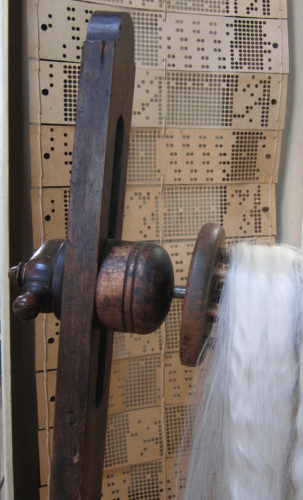
But the new technology used series of punched cardboard cards with the holes corresponding to a hook lifted or stopped, and transformed the process. These punched cards, with their binary codes (open/closed), were in fact the forerunner of modern computational devices – even to the use of punched cards!

A special room was required with a machine designed to punch these cards.
If these look familiar to readers who have seen the punchcards used to program computers up through the 1970s, it is because the Jacquard loom was a direct forerunner of modern computing. Charles Babbage and his famous young protegé Ada, Countess Lovelace (the daughter of Lord Byron), were the first to see this connection and to articulate the potential of mechanical computation and to define what became computer programming.
It is said that Ada herself was the first real programmer. Curiously, Babbage’s demonstration of his new “Difference Engine” to the seventeen-year-old Ada took place at a party in 1833 at 1 Dorset Street, a stone’s throw from Holmes’ and Watson’s residence in Baker Street, many years later. (Note: not the same Dorset Street in Spitalfields of Ripper fame.)

Another curious coincidence, both computer pioneers died in Marylebone (same area of London as Baker Street) near the time of Holmes’ birth.
But what is important here is that Holmes at this moment recognizes and ponders the potential use of computation to solve problems that require massive data sifting. He is very likely, then, to have read the Countess of Lovelace’s famous writings on the topic in which she said, “The Analytical Engine weaves algebraic patterns just as the Jacquard Loom weaves flowers and leaves.” But he hasn’t much time at this precise moment to think further on it…
CHAPTER TWENTY-FOUR
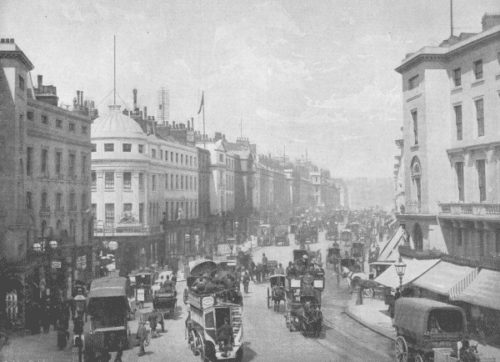
Verrey’s Restaurant
Located at the corner of Regent Street and Hanover Street, this restaurant was extremely popular and had been in place for at least fifty years at the time of this tale.
Noted for its sweetmeats, authentic French cuisine and pistachio ices, it enjoyed a steady clientele of Americans for early lunch, then ladies who wanted a break from shopping. At this time there were few places considered respectable enough for unaccompanied women, but as early as the 1850s, Verrey’s Café and Restaurant was considered so, and was listed in “Women in the Victorian Art World.” In the evening, crowds of elegant diners enjoyed bouillabaisse, a dish served every Sunday throughout winter. With a letter of appreciation from Charles Dickens framed and hanging in the dining room, the restaurant was described in the contemporary book “London Today” as having “no meretricious decorations” but rather “the comfortable simplicity of the Boulevard restaurants.” Verrey’s reputation and proximity to Baker Street would surely have attracted Holmes and Watson, though at this point in their careers, the restaurant may have been a bit too costly for regular dining. But perhaps they occasionally celebrated the conclusion of a successful case there, as they did at Simpson’s on the Strand.
To give an idea of a menu at Verrey’s, Lieut.-Col Newnham-Davis wrote in his 1899 “DINNERS AND DINERS: Where and How to Dine in London” of the following menu he fixed with the owners to accommodate a well traveled, highly cultured lady. They were served, no less:
Petite marmite.
Oeufs à la Russe.
Soufflé de filets de sole à la Verrey.
Timbale Lucullus.
Noisettes d’agneau à la Princesse.
Petits pois à la Française.
Pommes Mirelle.
Aiguillettes de caneton à l’Orange.
Salade Vénétienne.
Pouding Saxon.
Salade de fruits.
CHAPTER TWENTY-FIVE

Bermondsey
In 1888, the year of this tale, Bermondsey was included officially in the county of London, as a part of the borough of Southwark. Called “land of leather” at the time of the story, and later nicknamed “Biscuit Town,” Bermondsey was originally rural and wealthy, later suburban and monied (and with a notable Spa) but by the mid-nineteenth century had descended in class and was highly industrialized.
Poverty stricken, Bermondsey was generally described as dirty, desperate, and dangerous. Dickens immortalized the area in Oliver Twist, and the character of Bill Sykes famously met his death there. Between 1831 and 1901 the population of Bermondsey nearly tripled, causing intense crowding.

It was home to the tanning industry, the Peek Frean biscuit company and many other food processing factories as spin-offs to the localized shipping trade. Bermondsey counted among its many residents coal porters, costermongers, sailors, tanners, and other labourers who packed the dank waterside tenements, often four or five to a room. Child labour was rampant in the factories, often hidden after the regulations of the mid nineteenth century. And it stank, apparently. Not only the odours of the food processing plants but the strong scents of the tanning industry gave the air a distinctive smell. It would have been a very dangerous area for a child.

Peek Frean Biscuit Company
Peek Frean was a well-known baking company, renowned for its biscuits (cookies). Here is an advert from 1891, just three years after this story.
Their biscuits were wildly popular for over a hundred years, until the brand was bought by Kraft and discontinued in 1989. At the time of this story, their main factory was in Bermondsey and the area was flooded daily with varied aromas, depending on the particular type of biscuit being baked that day.

Two types in particular were most likely to have scented the Bermondsey air in 1888. The first was the “Garibaldi” biscuit, introduced in 1861, which featured squashed currants in a mildly sweet dough, and is still known jokingly as the “dead fly biscuit” because of its appearance.
The second candidate was The Marie, introduced in 1875, a plain round biscuit lightly scented with vanilla and often served to children, or with butter, marmite, or condensed milk sandwiching two together.

It was probably the smell of one of these two biscuits that assailed Vidocq during his mission in Bermondsey, and which offended his French olfactory sense, accustomed as he was to French pastries. These biscuits, however, are both excellent with tea, and still popular today.

Abcd’ere
Similar to the English or American sampler, this is a French term for a detailed embroidery project featuring a highly decorated alphabet, a common craft project for girls throughout the nineteenth century and beyond. Vidocq uses it in reference to fancifully embroidering a story.
CHAPTER TWENTY-SIX
Witchcraft
Picture a tall, cadaverously thin man, dressed entirely in black, who is able to tell your secrets from a single glance, and is then caught digging up a grave at night. Add a severed finger in his pocket and… it is easy to imagine that an uneducated, rural Englishman of the nineteenth century might well be swayed to think that Sherlock Holmes was doing the Devil’s work.
The Industrial Revolution and the rise of scientific method in Victorian Britain paradoxically (and perhaps in reaction) ushered in a new interest in spirituality and mysticism, embodying a wide range of ideas from Theosophy to fairies. But as science supplanted black magic as the explanation for failed crops and deadly illnesses, people tended to abandon the notion of witches and black magic. It retained its power, however, among the uneducated classes.

Whether Boden actually convinces his minions of Holmes’ witchcraft, or merely holds sway with his own methods is irrelevant. What is really at work here is that Boden’s kangaroo court is illegal, immoral, and highly irregular. It indicates deep corruption, and Boden’s stranglehold on the local law is no doubt funded by very deep pockets nearby. Corruption in local government was not unheard of then, though to this degree would be unusual.
In spite of the educated classes who “knew better” superstition is never far from human consciousness. Consider that Stevenson’s famous story of Dr. Jekyll and Mr. Hyde was at the apex of its popularity just at this time. First published in 1886, it was adapted for the stage, and opened in London in 1887 starring the charismatic Richard Mansfield, whose violent depiction was so impressive that the actor himself was questioned by Scotland Yard in the Ripper investigation. Below is a photograph promoting this production.
Think belief in witches is dead now? Hardly. As recently as 2007, a USA TODAY poll stated that nearly one fifth of Americans believe in spells or witchcraft. Salem, anyone?

Whipping As A Punishment
By the time of this story, physical punishment such as the stocks or pillory were viewed as barbaric and no longer an official part of the British penal system. While whipping continued as a legal punishment for women through 1817 and men in the 1830s, it was abolished officially in the 1840s, yet newspaper accounts reveal its persistence.
Pictured here is a whipping post such as the one Watson describes. It was, until recently, on display at the Clink Museum in London. Such a device would have been outmoded but still extant at the time of this story.
It is presumed that the remoteness of this Lancashire village of Penwick (a fictionalized name as in so many of Watson’s tales) gave some protection to the villain Boden to pursue his illegal and highly irregular form of “justice.”
In North America, however, whipping was still a viable punishment in 1888, and in a first-hand account of a public whipping in a Toronto newspaper of the times, a prisoner condemned to twenty lashes by the cat o’ nine tails (less than our two victims) was described as follows: “his back, from the neck to the waist, was one livid mass, red, swollen and bleeding, every knot on the lash had cut into the prisoner’s back, producing a wound about an eighth of an inch in length.” After twenty lashes, the prisoner was shaking uncontrollably, clearly in shock.
CHAPTER TWENTY-SEVEN
Meds For Morning Sickness In Victorian Times
Oranges, rhubarb and magnesium were among the various remedies recommended by doctors for morning sickness during Victorian times. An orange in wintertime would be a rare luxury in the north of England and probably caught Holmes’ sharp eye. Watson would know of these, but lacking Holmes’ powers of observation, that he would miss the connection is typical. More curious is the fact that Holmes knows these remedies in particular.

Blood Tranfusion
In 1888, massive blood loss was typically a death sentence. Transfusion was in its infancy, and various liquids including human blood, animal blood, water, saline solution and even milk had been tried over the years, usually with fatal results. Saline solutions sometimes worked. Occasionally human blood had been attempted, particularly in the battlefield, but as human blood types were not yet understood or discernable, it rarely worked. The process of person-to-person transfusion is shown in this 1888 illustration, which would have been similar to what was set up when Watson donated blood to save Holmes. A more complex device of the era is also shown.

The patient survived only when the blood types matched, which was roughly only thirty-five percent of the time. Both Watson and Mrs. Philo would have had experience in wartime with this. Transfusing Holmes was a real gamble in this case, but desperate measures require desperate action. In addition to the danger to the recipient, the risk of infection and shock to the donor were high, thus making this a real act of bravery on Watson’s part.
CHAPTER THIRTY
Holmes’ Fracture
It is nearly inconceivable that Holmes could have suffered a compound fracture (in which the broken bone juts through the skin) in this incident and not only lived but healed completely and quickly. Immediate surgery and massive sterilization efforts would have been required and yet are not described here. In very short order the following year, Holmes is depicted as physically active and so it is probable that the fracture remained internal but Watson took precautions in sterilizing the skin in case of a breach. In this manuscript it is one of the areas blurred by degradation. Nevertheless, x-rays did not yet exist, (the first was in 1895) and so a bone specialist would most probably have been called in. One practised nearby on Harley Street at that time.

Cylinder Phonograph Of 1888
This would be a rare item indeed at this time, but it did exist in the form similar to the one seen below, in possession of the curator of this story. Toulouse Lautrec was famously wealthy and well connected, and loved to entertain; he could possibly have possessed one. Holmes was always up on the latest technology and his passion for music would have made this a treasured possession, though it is only mentioned in Watson’s tale of The Mazarin Stone, the authenticity of which has long been debated. As will no doubt this tale. The photo below is from the curator’s collection and dates approximately two years after this story.
Mindfulness Meditation
While “mindfulness meditation” is part of our modern lexicon, this exact term was unknown at the time of this tale. Yet it is undoubtedly a variant of this particular form of Eastern practice which Holmes describes to Watson as being critical to his recovery from grievous injury in this story.
It is elsewhere described, though not named by Watson as a part of Holmes’ problem solving process. Watson refers to Holmes’ practice of sitting quite still for long periods of time “putting his brain out of action,” as he describes in “The Man With the Twisted Lip”:
A large and comfortable double-bedded room had been placed at our disposal, and I was quickly between the sheets, for I was weary after my night of adventure. Sherlock Holmes was a man, however, who, when he had an unsolved problem upon his mind, would go for days, and even for a week, without rest, turning it over, rearranging his facts, looking at it from every point of view until he had either fathomed it or convinced himself that his data were insufficient. It was soon evident to me that he was now preparing for an all-night sitting. He took off his coat and waistcoat, put on a large blue dressing-gown, and then wandered about the room collecting pillows from his bed and cushions from the sofa and armchairs. With these he constructed a sort of Eastern divan, upon which he perched himself cross-legged, with an ounce of shag tobacco and a box of matches laid out in front of him. In the dim light of the lamp I saw him sitting there, an old briar pipe between his lips, his eyes fixed vacantly upon the corner of the ceiling, the blue smoke curling up from him, silent, motionless, with the light shining upon his strong-set aquiline features. So he sat as I dropped off to sleep, and so he sat when a sudden ejaculation caused me to wake up, and I found the summer sun shining into the apartment. The pipe was still between his lips, the smoke still curled upward, and the room was full of a dense tobacco haze, but nothing remained of the heap of shag, which I had seen upon the previous night.

Clearly a formal meditation. But where did he learn it? Clues abound.
Buddhism was a hot topic at this time in Victorian England. By 1888, three book-length poems about Buddha had been recently published, most famously The Light of Asia by Sir Edwin Arnold, and Sakya Muni: The Story of Buddha, which won the Oxford Newdigate prize in the year preceding the events of this story.
The question arises, did Holmes find his own personal path to meditation through reading these or perhaps through contact with some individual or organization as a young man by 1888? There was, in fact, such an organization in London at the time – The Pali Text Society, which was founded in 1881 by the controversial but scholarly Thomas William Rhys Davids.
Posted as a civil servant to Ceylon (now Sri Lanka), Rhys Davids was required to learn the language and culture. Tutored by Buddhist monks, he became interested in the philosophy. Pali is the language of the texts of the particular branch of Buddhism known as Theraveda, which is the form that gave birth to Vispassana meditation, now frequently interpreted in the West as “Mindfulness Meditation.”

When Rhys Davids returned to London he and his wife formed the Pali Text Society to translate and preserve the original writings.
This group put out “dozens of texts” before the end of the 19th century, and it is likely that Holmes, always a “seeker” in terms of what might be useful to his process, might well have come into contact with this practice. The Pali Text Society, now relocated to Wiltshire, continues to this day.
The potential appeal of Theraveda/Vispassana meditation to Sherlock Holmes is clear. Theraveda Buddhism, which promotes the concept of Vibhajjavada (Pali), is literally “Teaching of Analysis.” The practice of meditation would be just another form of rigorous mental discipline to the Great Detective. The benefits of mindfulness meditation include reduction of pain, lightening of depression, focused concentration, clarity, and equanimity – all of which would have been appreciated by Holmes, and particularly helpful during his recovery from the events of this tale.
Says Maria Konnikova, author of Mastermind: How to Think like Sherlock Holmes: “His approach to thought captures the very thing that cognitive psychologists mean when they say mindfulness.”

Today, the Vispassana tradition is embodied in the teachings of such esteemed modern Western masters such as Shinzen Young.
Shinzen has developed a comprehensive system and categorized method of teaching mindfulness meditation techniques designed for Western minds. His method particularly appeals to scientists, mathematicians, and artists in its specificity, structure, and clarity. His sense of humor also goes a long way to making this accessible.
It seems highly likely that Holmes, at the time of this tale, already practised a form of structured, mindfulness meditation, as indeed we see in depictions of this very state in other Watson tales.
Meditation training often begins with traditional seated practice but expands to incorporate moving meditation, and ultimately to finding ways to access the meditative mindset during other activities —receptive as in listening to music, or active as in, writing, painting, or sports.
In FLOW, his seminal book about optimal performance, Mihaly Csiksentmihalyi describes the perception of time slowing down that occurs when we achieve that particular relaxed but focused state. In martial arts, this can seem to bestow almost supernatural powers. In the Robert Downey, Jr. depictions of Sherlock Holmes, this is graphically represented with slow motion sequences. And in Watson’s original depictions, Holmes himself describes his deductions as happening so quickly he can barely describe them.
Meditation is common among artists of many kinds, and it can be also be argued that the high level practice of any art form is in itself a form of mindfulness meditation.


May 6, 2018
Thank you for the historical background references to your two exceptional works of art. Your love of literature, especially Sherlockian works is very evident and one I can totally relate to. Keep on writing.
June 4, 2018
Thank you, Brenda. So glad you are enjoying these! It’s great to hear from readers!
November 4, 2019
Excellent Holmes pastiche!